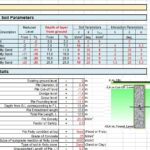
Slope Stability Analysis Static and Dynamic Spreadsheet
2 January 2025 Off By The Engineering CommunityTable of Contents
Slope Stability Analysis Static and Dynamic Spreadsheet
Slope stability is a critical aspect of geotechnical engineering and environmental management that affects infrastructure, natural landscapes, and safety. From hillside communities to large construction projects, the importance of ensuring stable slopes cannot be overstated. In this article, we delve into what slope stability is, the factors influencing it, and the measures to ensure safe and stable slopes.
What is Slope Stability?
Slope stability refers to the ability of a slope—whether natural or man-made—to resist failure or landslides. When the forces acting to destabilize the slope exceed the forces holding it together, slope failure occurs. This phenomenon can lead to catastrophic consequences, including property damage, environmental degradation, and loss of life.
Engineers and geologists analyze slope stability to design safe structures and predict potential landslide zones. Understanding the factors affecting slope stability is the first step in mitigating risks.
Factors Influencing Slope Stability
Several factors contribute to slope stability, and understanding these is essential for effective analysis and prevention of slope failure.
1. Geological Conditions
The type of soil or rock, its composition, and structure significantly affect slope stability. Loose, unconsolidated materials are more prone to failure than compacted, cohesive soils or solid rock formations.
2. Slope Angle and Height
Steeper slopes are inherently less stable. Similarly, taller slopes exert more pressure at the base, increasing the likelihood of failure.
3. Water Content
Water is a critical factor in slope stability. Excessive moisture reduces soil cohesion and increases weight, making the slope more prone to failure. Poor drainage systems can exacerbate these conditions.
4. Vegetation Cover
Plants and trees play a vital role in stabilizing slopes. Their roots bind the soil, while vegetation reduces surface erosion. Conversely, deforestation can significantly increase the risk of slope instability.
5. External Loads and Human Activity
Construction, mining, and other human activities can impose additional loads on slopes. Poorly planned developments can weaken slopes and lead to failure.
6. Seismic Activity
Earthquakes and vibrations destabilize slopes by shaking loose materials and reducing frictional resistance between soil particles.
Assessing Slope Stability
Assessing slope stability involves both qualitative and quantitative methods. Engineers use techniques such as:
- Field Investigations: Collecting soil and rock samples to analyze their properties.
- Slope Stability Analysis Software: Modeling the slope’s behavior under different conditions.
- Instrumentation and Monitoring: Using inclinometers, piezometers, and other devices to monitor slope movement and water pressure.
Methods to Improve Slope Stability
1. Reinforcement
Techniques like soil nailing, rock bolting, and retaining walls enhance the slope’s strength and prevent failure.
2. Drainage Systems
Effective drainage reduces water buildup, which is a significant cause of slope instability. Methods include installing surface drains, sub-drains, and geotextiles.
3. Revegetation
Planting vegetation helps bind the soil and reduces erosion. It is a cost-effective and environmentally friendly method.
4. Grading and Slope Modification
Reducing the slope angle or creating stepped terraces can significantly improve stability.
5. Use of Retaining Structures
Gabion walls, sheet piles, and concrete retaining walls provide support to unstable slopes.
The Importance of Slope Stability in Modern Infrastructure
In modern infrastructure, slope stability plays a pivotal role in ensuring the safety and longevity of structures. Roads, railways, dams, and residential developments on or near slopes must incorporate rigorous stability assessments during planning and construction phases. Ignoring these assessments can lead to costly repairs, legal liabilities, and endanger lives.
Real-World Examples of Slope Stability Projects
1. Hong Kong Landslide Mitigation
Hong Kong, a region with steep terrain, has implemented advanced slope stabilization measures, including soil nailing and drainage systems, to prevent landslides during heavy rainfall.
2. Highway Embankment Stabilization
Many highways traverse mountainous regions. Stabilizing embankments with retaining walls and proper drainage ensures safe travel routes for motorists.
Conclusion
Understanding and addressing slope stability is crucial for safeguarding lives, protecting investments, and preserving the environment. With a combination of modern engineering techniques and natural methods, slope failures can be effectively prevented. Whether you’re a property developer, an engineer, or simply someone living near a slope, prioritizing slope stability is an investment in safety and sustainability.
More from my site
 Calculation Of Bridge Scour Using The Erodibility Index Method Spreadsheet
Calculation Of Bridge Scour Using The Erodibility Index Method Spreadsheet Slope stability by the Simplified Bishop method
Slope stability by the Simplified Bishop method Geotechnical Cross Section Free Autocad Template
Geotechnical Cross Section Free Autocad Template Pile Capacity All Calculations Spreadsheet
Pile Capacity All Calculations Spreadsheet Slope Stability Calculation Simplified Bishop Method Spreadsheet
Slope Stability Calculation Simplified Bishop Method Spreadsheet Analysis Tool On Soil Liquefaction Potential Spreadsheet
Analysis Tool On Soil Liquefaction Potential Spreadsheet


